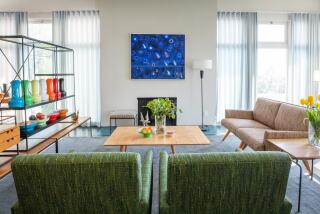Home design gets a global spin
- Share via
Shifting reading habits and a brutal recession may have caused the demise of Domino, Metropolitan Home and House & Garden, not to mention smaller publications such as Oprah Winfrey’s O at Home and Martha Stewart’s Blueprint, but a surprising phenomenon has been developing elsewhere: While shelter magazines fold in the States, a new generation of interior design titles has taken off in Brazil, Russia and, most aggressively, China.
We’re not talking digital click-throughs, the online decorating guides such as Lonny that have sprung up here, sometimes staffed by writers and editors who were laid off during the industry meltdown.
No, these new foreign shelter magazines are glossy paged journals dedicated to showing the latest and greatest in furniture, fixtures and appliances. They walk readers through the homes of yuan-aires and ruble-aires. Brick-heavy with ads, the magazines hearken to the pre-recession age of home design publishing in the U.S.
“This is all about the explosion of the middle class and the mass urbanization of certain countries,” said Mark Strauss, president of Interior Design Media Group, a division of Sandow Media, which prints Interior Design and Luxe magazines as well as the trade newspaper Furniture Today in the U.S. “People are starting to have nicer homes, so they want nicer things, which in turn means that they want to see what those nicer things are.”
Architectural Digest Editor in Chief Margaret Russell set the blogosphere blazing this February when she announced that the 91-year-old Conde Nast magazine would begin publishing in China. The first issue of Architectural Digest China published in April, and Architectural Digest India is expected to launch in 2012.
In April, Sandow Media acquired Surface Asia, Surface China and Interior Design China — titles that Strauss said “are becoming incredibly successful in a very short period of time.”
“I’m now looking to Korea,” he said.
But foreign-owned media companies are not the only ones driving the surge. Many new entrants to the field are home-grown publications. In the past two years alone, more than a dozen small design magazines have launched in Russia.
Home Magazine, a Russian publication that started in 2009, has a circulation of 10,000 — minuscule compared with a U.S. title such as House Beautiful, which typically has a monthly run of about 800,000. Even so, Home’s aims are international, not provincial, Editor in Chief Natalia Pirogova said, who emphasized that she has landed some of the biggest names in home furnishings.
“We’ve interviewed people like Karim Rashid and Jaime Hayon, along with features on up-and-coming designers as well,” said Pirogova, who maintains that her country’s growing wealth has led to the birth of a new industry.
“Many people have become rich here, so they’re moving from small apartments into large houses,” she said, adding that “interior design has suddenly become very important for them.”
Casa Vogue, a shelter offshoot of the fashion magazine, has been publishing in Brazil for almost 25 years, but only recently has it faced serious competition for advertising dollars.
“A publication called Minha Casa launched last year, and this year two new interior design magazines were launched: Bamboo and Wish Casa,” says Winnie Bastian, editor of Casa Vogue’s recently launched website. “They are our direct competitors here in Brazil, where the middle class is growing very strongly.”
Hearst and Conde Nast declined to supply traffic numbers for websites associated with their magazines, making comparisons difficult. But Bastian said the Casa Vogue site, still in its beta phase, already is a success with 90,000 unique visitors a month.
What’s happening in Brazil and Russia pales in comparison to the explosion of home publications in China, where dozens of titles have launched in the past three years. Many have English names such as Residence, Home Idea Magazine and the slightly less intuitive Home-My Living, but the headlines and articles are all in Mandarin or Cantonese.
“Is there a real estate bubble going on there or not? Either way you have a lot more people with bigger homes that have to be furnished,” said Strauss, noting that China’s residents populate an “astounding” number of metropolitan areas that are equal in size or larger than Los Angeles County.
Chinese editors, in fact, often look to L.A. for ideas about how to decorate all those new homes. Though the U.S. may have a $25 billion trade deficit with China, one American export clearly is surging: modern California style.
“About six months ago the flood gates opened,” West Hollywood interior designer Jamie Bush said. “We were on some international blogs, and then all of a sudden, the calls started coming in. Five separate Chinese publications have contacted me in just a few months, and many of them have featured my projects.”
The designer said so far this year, he’s also been published in Brazil, Russia and Bulgaria. This month, a team of photographers from Architectural Digest Germany will fly in to photograph a Brentwood home that he designed in collaboration with L.A. architect Bruce Bolander.
Even if boom days are over for American design magazines, as some analysts have suggested, new initiatives are heading to newsstands in the not-so-distant future. Hearst said it will roll out the first issue of an HGTV magazine this October. But will a print version of the home and garden TV channel be enough to cure those Domino withdrawals? If not, perhaps American readers will be looking halfway around the globe, where it’s safe to bet another new design magazine will be headed for the printer.
More to Read
Inside the business of entertainment
The Wide Shot brings you news, analysis and insights on everything from streaming wars to production — and what it all means for the future.
You may occasionally receive promotional content from the Los Angeles Times.










